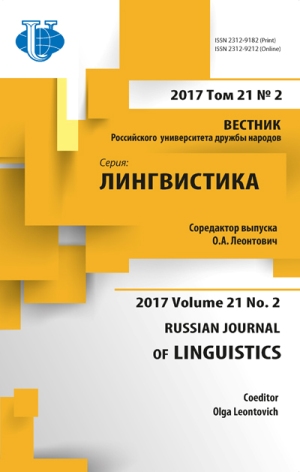“A Significant Part of an Insignificant Identity”: the Re-Articulation of North-East Scots between Tradition and Globalization
- Authors: Loester B.1
-
Affiliations:
- University of Winchester
- Issue: Vol 21, No 2 (2017)
- Pages: 335-347
- Section: Articles
- URL: https://journals.rudn.ru/linguistics/article/view/15901
- DOI: https://doi.org/10.22363/2312-9182-2017-21-2-335-347
Cite item
Full Text
Abstract
In Britain the conflict between the national standard and regional languages and varieties, or rather those perceived to be ‘only’ a dialect, is still going strong and Scots plays a peculiar role in it. It is recognised and afforded a certain level of protection and promotion under the European Charter for Regional and Minority Languages (ECRML). While related to English, Scots has a number of regional varieties and it stands in competition with other varieties of English within Scotland. North-East Scots (NE Scots), also known as ‘the Doric’, in particular occupies a rather special place within the sphere of Scots. While research has often focused on the perceived status of urban versus rural Scots, this paper examines the attitudes towards NE Scots with regard to identity construction as displayed by its speakers in rural areas and small towns in the North-East. Another focal point is the use of the regional variety as a perceived act of resistance against the ostensible dominance of English. Within the mind of its speakers what kind of identity do they feel they have - a largely local/regional, a national Scottish, a British one or something entirely different? The analysis of interview data highlights that respondents’ statements and their actual linguistic behaviour reinforce the affirmation of their regional identity; the extent to which this occurs will also be investigated.
About the authors
Barbara Loester
University of Winchester
Author for correspondence.
Email: barbara.loester@winchester.ac.uk
Sparkford Road, Winchester, SO22 4NR, United Kingdom
References
- Aitken, A. J. (1981) The good old Scots tongue: Does Scots have an identity? In Einar Haugen, Derrick J. McClure and Derick Thomson (eds.), Minority Languages Today, 72-90. Edinburgh: Edinburgh University Press
- Allan, David. (2001) Kenneth mac Alpin. In Michael Lynch (ed.) Oxford Companion to Scottish History. Oxford: Oxford University Press
- BBC News. (2006) Subtitle decision ‘puzzles’ Scots. 4 August. [http://news.bbc.co.uk/go/pr/fr/-/1/hi/ entertainment/5244738.stm]. Last accessed 04/08/2016
- Elphinstone Institute, University of Aberdeen (n.d.). The Elphinstone Kist. [http://www.abdn.ac.uk/ elphinstone/kist/welcome.hti]. Last accessed 01/12/2015
- Giles, Howard and Patricia Johnson. (1987) Ethnolinguistic identity theory: a social psychological approach to language maintenance. International Journal of the Sociology of Language, 68, 69-100
- Görlach, Manfred. (1990) Scots and Low German: the social history of two minority languages. In Manfred Görlach (ed.), Studies in the History of the English Language. Heidelberg: Universitätsverlag C. Winter. 144-162
- Hendry, Ian David. (1997) Doric: An investigation into its use amongst primary school children in the North-East of Scotland. Aberdeen: University of Aberdeen M. Litt. Thesis
- Iacuaniello, Flavia. (1992, 1993) Linguistic awareness and attitudes in a sample of Scottish speakers. Scottish Language 11/12: 62-71
- Imamura, Mari. (2004) Primary school teachers’ attitudes towards the Scots language in education in the North-East of Scotland. Aberdeen: University of Aberdeen Ph.D. thesis
- Itchy Coo. (Accessed on 1st September 2016) ‘Aboot us.’ Retrieved from: http://www.itchy-coo.com/ abootus.html
- Jones, Charles (1997) The Edinburgh History of the Scots Language. Edinburgh: Edinburgh University Press
- Kloss, H. (1978) Die Entwicklung neuer germanischer Kultursprachen seit 1800. 2, erweiterte Auflage. Düsseldorf: Pädagogischer Verlag Schwann
- Loester, B. (2009) A contrastive study of language attitudes and identity construction in the North-East of Scotland and Bavaria. Aberdeen: University of Aberdeen Ph.D. thesis
- Löw-Wiebach, Danielle A. V. (2005) Language Attitudes and Language Use in Pitmedden (Aberdeenshire). Frankfurt am Main: Peter Lang
- Macafee, Caroline. (1994) Traditional Dialect in the Modern World: A Glasgow Case Study. Frankfurt: Peter Lang
- Macafee, Caroline. (2001) Scots: hauf empty or hauf fu? In John M. Kirk and Dónall P. ÓBaoill (eds). Linguistic Politics. Language Policies for Northern Ireland, the Republic of Ireland, and Scotland. Belfast: Cló Ollscoill na Banríona. 159-168
- McClure, J. Derrick, John Corbett and Jane Stuart-Smith (eds. 2003) The Edinburgh Companion to Scots. Edinburgh: Edinburgh University Press
- McClure, J. Derrick. (2002) Doric: The Dialect of North-East Scotland. Amsterdam & Philadelphia: John Benjamins
- McGarrity, Briege. (1998) A sociolinguistic study of attitudes towards and proficiency in the Doric dialect in Aberdeen. Aberdeen: University of Aberdeen M. Phil. Thesis
- McRae, Sandra M. (2006) Demonstrative use in the Lower Garioch: A study of change in progress. Aberdeen: University of Aberdeen Ph.D. thesis
- Marshall, Jonathan. (2003) The changing sociolinguistic status of the glottal stop in northeast Scottish English. English World-Wide 24. 89-108
- Máté, Ian. (1996) Scots Language Research Report. Edinburgh: General Register Office for Scotland (GROS)
- Middleton, Sheena. (2001) A Study into the knowledge and use of Scots amongst primary pupils on Upper Deeside. Aberdeen: University of Aberdeen M. Litt. dissertation
- Millar, Robert McColl. (2006) “Burying alive”: unfocussed governmental language policy and Scots. Language Policy 5. 63-86
- Millar, Robert McColl. (2007) Northern and Insular Scots. Edinburgh: Edinburgh University Press
- Mitchison, Rosalind. (1990) A History of Scotland. 2nd edition. London: Routledge
- Murdoch, Steve. (1995) Language Politics in Scotland. Aberdeen: AUSLQ
- National Records of Scotland. (2013) Census 2011. Release 2A. Retrieved from: http://www.scotlandscensus.gov.uk/news/census-2011-release-2a
- National Records of Scotland. (Accessed on 14 September 2016) Scotland’s Census. Area profiles. Retrieved from: http://www.scotlandscensus.gov.uk/ods-web/area.html
- Ong, Walter J. (1982) Orality and Literacy. The Technologizing of the World. London: Methuen
- Patterson, S. (2006) Fishermen in a storm over Doric dialogue in BBC film. The Scotsman, 4 August. Retrieved from: http://www.news.scotsman.com/scotland.cmf?id=1127832006
- Robinson, Mairi (1985) The Concise Scots Dictionary. Aberdeen: Aberdeen University Press
- Schmitt, Holger. (2009) Sprache und Identität in Schottland: Eine qualitative Makrostudie zur Rolle des Tiefland-Schottischen (Scots). Heidelberg: Universitätsverlag Winter
- Scots Language Centre (Accessed on 14 September 2016) Aye can... speak Scots. Retrieved from: http://www.ayecan.com
- Scots Language Centre (Accessed on 13 September 2016) 2011 Census. Retrieved from: http://www.scotslanguage.com/articles/view/id/4635
- Smyth, Alfred P. (1984) Warlords and Holy Men. Scotland AD 80-1000. Edinburgh: Edinburgh University Press

















